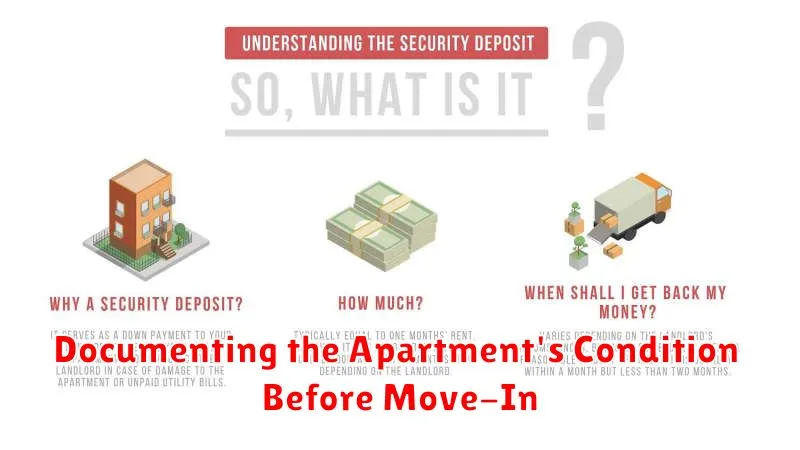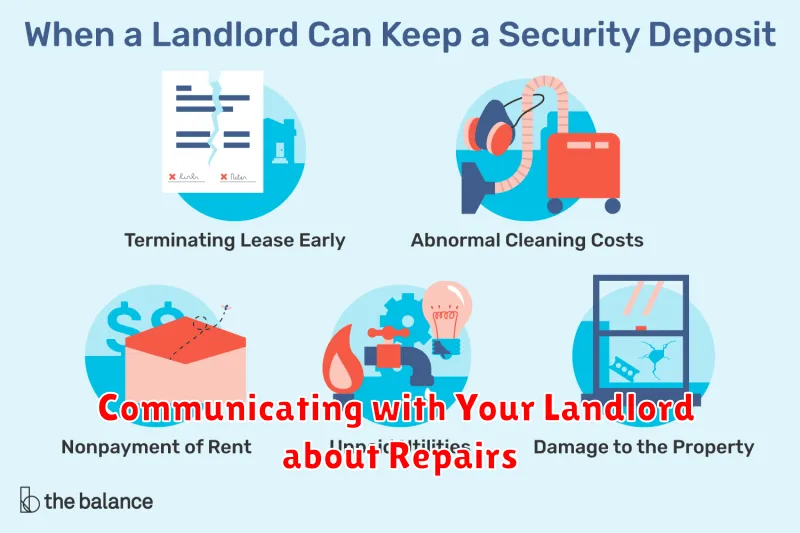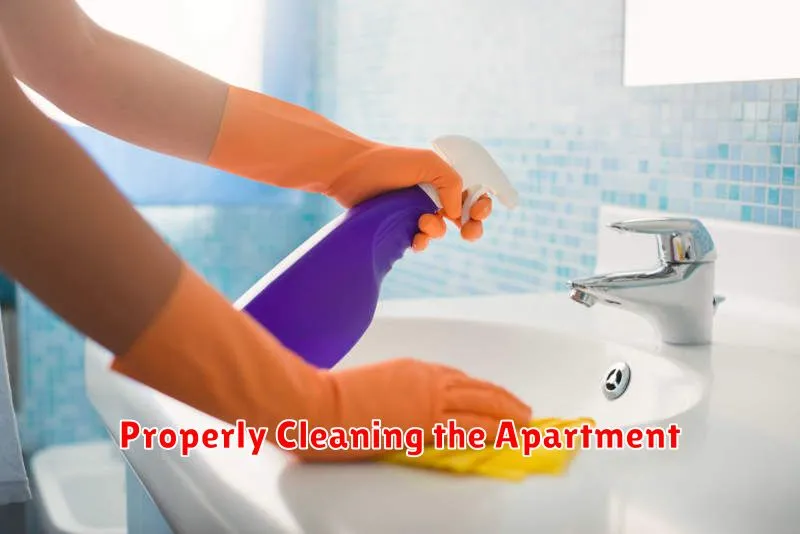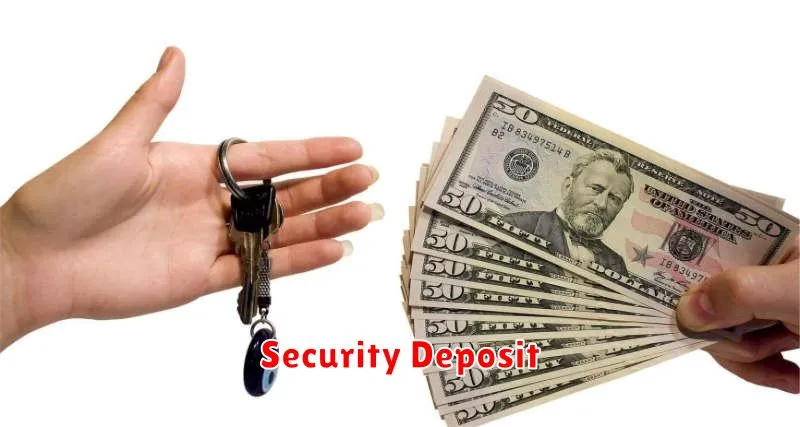Moving into a new apartment is an exciting time, but it can also be stressful. You want to make sure you’re getting the most out of your new space and that you’re protected financially. One way to do that is by understanding how your security deposit works and how to maximize your chances of getting it back in full when you move out. This guide will walk you through the essential steps to ensure a smooth transition and a successful return of your hard-earned money.
Understanding Your Security Deposit Rights
Before you even think about moving into your new apartment, it’s crucial to understand your security deposit rights. This money is essentially a safety net, protecting both you and the landlord. You pay it to cover potential damages you might cause to the apartment, and the landlord holds onto it to ensure the apartment is returned in good condition.
The first step is to read the lease agreement carefully. It should clearly state the amount of the security deposit, the purpose of the deposit, and the process for returning it. If you have any questions, don’t hesitate to ask your landlord for clarification.
Most states have laws regarding security deposits, so familiarizing yourself with your state’s specific regulations is important. These laws typically outline the landlord’s responsibilities for holding the deposit, the process for returning it, and the conditions under which deductions can be made.
It’s also wise to document the condition of your apartment upon move-in. Take detailed photos or videos to document the condition, and be sure to have your landlord witness the condition and sign off on it. This creates a clear record and can be helpful if there are any disputes about deductions from your deposit when you move out.
By understanding your rights and responsibilities, you can ensure a smooth and fair process when it comes to getting your security deposit back.
Documenting the Apartment’s Condition Before Move-In

One of the most important steps you can take to ensure you get your security deposit back is to thoroughly document the condition of the apartment before you move in. This documentation serves as a record of the apartment’s existing state, which can be crucial in resolving any potential disputes with your landlord later on.
To document the apartment’s condition effectively, follow these steps:
- Take detailed photos and videos of every room, including closets, bathrooms, and the kitchen. Focus on capturing any pre-existing damage, wear and tear, or imperfections, such as scratches on walls, stains on carpets, or broken appliances.
- Create a detailed written inventory of the apartment’s condition. This list should include specific details about each room, such as the color and condition of the walls, the type and condition of flooring, and any existing appliances and fixtures.
- Include timestamps on all photos, videos, and written documentation. This helps to prove that the documentation was created before you moved in.
- Get your landlord to sign and date the documentation. This step acknowledges that they are aware of the apartment’s existing condition, which can be helpful in resolving any disputes.
By taking the time to document the apartment’s condition thoroughly before you move in, you can protect yourself from any potential deductions to your security deposit. This documentation can serve as strong evidence if any disputes arise over the apartment’s condition at the end of your lease.
Maintaining the Apartment Throughout Your Tenancy
One of the most effective ways to maximize your chances of getting your security deposit back is to maintain your apartment throughout your tenancy. This involves taking care of the space as if it were your own, being mindful of wear and tear, and promptly addressing any issues that arise. Your landlord will appreciate your efforts, and you’ll be rewarded with a clean and comfortable living environment.
Maintaining your apartment includes a variety of tasks, ranging from basic cleaning to more extensive repairs. It’s essential to keep the space tidy and clean, regularly dusting and vacuuming, and wiping down surfaces. Consider cleaning the kitchen appliances, particularly the oven and refrigerator, on a regular basis.
It’s also important to be mindful of wear and tear. Over time, furniture and fixtures will naturally experience some level of degradation. However, you can minimize the impact by taking care of your furniture and belongings, avoiding excessive use of harsh cleaning products, and promptly addressing any issues that arise.
Should you notice any problems with your apartment, whether it’s a leaky faucet, a malfunctioning appliance, or a broken window, report them to your landlord immediately. Promptly addressing these issues can prevent them from escalating, potentially causing more damage and ultimately impacting your security deposit.
By consistently maintaining your apartment throughout your tenancy, you’ll create a positive impression on your landlord, enhance the overall living experience, and significantly increase your chances of receiving your security deposit back in full.
Communicating with Your Landlord about Repairs

It’s crucial to understand that maintaining your apartment in good condition is a shared responsibility between you and your landlord. Your landlord is responsible for major repairs, while you are generally responsible for minor repairs and general upkeep. However, it is always a good idea to communicate with your landlord about all repairs, regardless of their size. This can help prevent issues from escalating and ensure that you are aware of any potential liabilities.
When communicating with your landlord about repairs, it’s important to do so professionally and respectfully. Keep a record of all communications, including dates, times, and the nature of your request. If possible, document the repair with photos or videos. This documentation can be invaluable if a dispute arises.
Remember to be proactive about repairs. Addressing issues promptly can prevent them from becoming more serious and costly. Additionally, being proactive can help you maintain a good relationship with your landlord, which can be beneficial when it comes time to move out and receive your security deposit back.
Before making any major repairs yourself, always consult with your landlord first. In some cases, they may be able to provide you with a list of approved contractors or cover the cost of repairs. By following these tips, you can effectively communicate with your landlord about repairs and ensure that your apartment remains in good condition. This proactive approach can help you avoid unnecessary expenses and receive your security deposit back upon moving out.
Scheduling a Pre-Move-Out Inspection
One of the best ways to ensure you get your security deposit back in full is to schedule a pre-move-out inspection with your landlord or property manager. This is a great opportunity to address any concerns they might have about the condition of the apartment before you move out. During the inspection, the landlord can point out any areas that need to be cleaned or repaired. This gives you a chance to address these issues before you move out and potentially avoid having deductions from your security deposit. It also allows for a neutral third party to document the condition of the property and provide a clear record of the apartment’s condition upon your move-out.
To schedule a pre-move-out inspection, contact your landlord or property manager well in advance of your move-out date. Make sure to confirm the date, time, and any specific instructions for the inspection. It is also helpful to document the inspection in writing, including any issues that were discussed and agreed upon. This documentation can be helpful if there are any disputes about the condition of the apartment after you move out.
A pre-move-out inspection can be a valuable step in ensuring you get your security deposit back in full. By addressing any potential issues before you move out, you can save yourself time, hassle, and money.
Properly Cleaning the Apartment

One of the most important things you can do to get your security deposit back is to clean your apartment thoroughly. Landlords have a right to deduct from your security deposit for any damage or excessive dirtiness.
Here are some tips for properly cleaning your apartment:
- Dust and vacuum all surfaces, including walls, baseboards, furniture, and appliances.
- Clean all bathrooms thoroughly, including the shower, tub, toilet, and sink.
- Wash all windows and mirrors.
- Clean the kitchen thoroughly, including the stove, oven, refrigerator, and dishwasher.
- Clean out the pantry and discard any expired food.
- Empty all trash cans and recycling bins.
- Sweep and mop all floors.
- Clean all carpets and rugs.
- Remove any personal belongings, including furniture, decorations, and appliances.
If you are unsure about what needs to be cleaned, it is always best to err on the side of caution and clean more than you think is necessary. A clean apartment shows the landlord that you have taken good care of the property and that you are serious about getting your security deposit back.
Addressing Any Damages Promptly
One of the most important things you can do to get your security deposit back is to address any damages promptly. If you notice any damage to your apartment, report it to your landlord immediately. This is important for a few reasons. First, it shows your landlord that you are a responsible tenant who cares about the condition of the property. Second, it gives your landlord the opportunity to make repairs before the damage becomes worse. Third, it helps to avoid any disputes about who is responsible for the damage.
Even if the damage is minor, it is still important to report it. For example, if you accidentally break a lightbulb, it is important to report it to your landlord. This will prevent your landlord from assuming that you are responsible for the damage.
By addressing any damages promptly, you can increase your chances of getting your security deposit back in full. It shows that you are a responsible tenant and that you are taking care of the property.
Reviewing Your Lease Agreement
Your lease agreement is the contract between you and your landlord, outlining the terms of your tenancy. It’s crucial to read it carefully before signing to understand your rights and responsibilities, especially regarding your security deposit.
Look for clauses related to the security deposit. This should include details on:
- The amount of the deposit
- When and how it’s returned
- What deductions will be made for damages or cleaning
- The timeframe for making claims on the deposit
- The process for dispute resolution
If anything in the lease seems unclear or unfavorable, don’t hesitate to ask your landlord for clarification. It’s better to have things spelled out in writing than to rely on verbal agreements.
Pay attention to the condition of the apartment when you move in. Document any pre-existing damage with your landlord through a move-in inspection report. This helps prevent being charged for damages that were not your fault.
Keeping a copy of your signed lease agreement for your records is essential. This allows you to refer back to it if any questions arise during your tenancy, and ensures you have a solid reference when it comes to claiming your security deposit back at the end of your lease.
Understanding Deduction Policies
Before you even think about moving in, make sure you fully understand your apartment’s security deposit deduction policies. Every landlord has their own set of rules about what they’ll deduct from your deposit and how. This is crucial to avoid any surprises when you move out.
Read the lease carefully: Your lease should clearly outline the terms of your security deposit, including how much it is, what it’s for, and how it will be returned to you. Pay close attention to the section on deductions, as this will specify what the landlord can charge you for and how they will handle it.
Ask for clarification: If anything is unclear, don’t hesitate to ask your landlord for clarification. It’s better to be safe than sorry. Don’t assume anything. Understanding the deduction policies upfront can save you from a potential financial headache later.
Document everything: Keep records of any repairs or maintenance issues you report to your landlord. This can be helpful if the landlord tries to deduct from your security deposit for something you didn’t cause. Photos and videos can provide valuable evidence.
By understanding and following the deduction policies, you can minimize the chances of losing your security deposit and ensure a smooth transition when you move out.
Documenting the Apartment’s Condition After Cleaning
One of the most important steps in getting your security deposit back is documenting the condition of your apartment after you clean it. This means taking detailed photos and videos of every room, including any potential areas of concern.
Here are some tips for documenting the condition of your apartment:
- Take photos and videos of every room, including closets, bathrooms, and the kitchen.
- Make sure the photos and videos are clear and well-lit.
- Focus on any potential areas of concern, such as scratches on the walls, stains on the carpet, or broken appliances.
- Take photos from multiple angles, so that the landlord can see the entire area.
- Include photos and videos of any repairs or maintenance that you have done to the apartment.
It’s also a good idea to create a checklist of all the tasks you completed when cleaning your apartment. This will help you to ensure that you have not missed anything.
By documenting the condition of your apartment, you can provide your landlord with clear evidence that you have left it in a clean and habitable condition. This will increase your chances of getting your security deposit back in full.
Following Up with Your Landlord After Move-Out
After you’ve moved out of your apartment, it’s crucial to follow up with your landlord to ensure a smooth process for receiving your security deposit back. This step can be overlooked, but it’s essential for protecting your rights and receiving a timely refund.
The first step is to review your lease agreement. Your lease will outline the timeframe for your landlord to return your security deposit and the process for requesting it. Some leases require a written request for the deposit, while others may have a specific form that needs to be filled out.
Once you’ve reviewed your lease, send a written request for your deposit within the specified timeframe. This request should include your contact information, the address of the apartment, and the date you moved out. Be sure to keep a copy of this request for your records.
It’s a good idea to follow up with your landlord after sending the request. You can do this via email or phone call. During this follow-up, you can ask about the status of your deposit and inquire about any deductions that may be made. It’s also beneficial to document all communication with your landlord, including dates and times of conversations and copies of emails.
If your landlord fails to return your deposit within the specified timeframe or makes unauthorized deductions, you can pursue legal action. However, by being proactive and following up regularly, you can greatly increase the chances of receiving your security deposit back quickly and without any unnecessary hassle.
Negotiating Disputed Deductions
If your landlord deducts money from your security deposit for damages that you feel are unreasonable or are not your fault, you have the right to dispute them. You should contact your landlord and explain your reasoning for disputing the charges. Be polite and professional, and keep all communication in writing, including emails, letters, or text messages. Keep a record of your correspondence.
If you can’t resolve the issue with your landlord directly, you can try to contact a local tenant’s rights organization or legal aid society. These organizations can provide you with information and guidance on your rights as a tenant and may be able to help you negotiate with your landlord or take further action.
Be prepared to present evidence to support your case. For example, if you are disputing a charge for a cleaning fee, you may want to provide photos of the apartment before you moved out. If you are disputing a charge for a repair, you may want to provide receipts for any repairs that you had done yourself.
If you are still unable to reach a resolution, you may need to file a small claims lawsuit. This is a legal process that allows you to sue your landlord for damages, such as the amount of money that was wrongfully deducted from your security deposit.
Knowing Your Legal Recourse
Before you even think about moving into your apartment, it’s essential to know your legal recourse regarding your security deposit. Every state has its own set of laws regarding security deposits, so it’s crucial to research your state’s specific laws. You can find this information on your state’s government website or by consulting with a real estate lawyer.
Generally, landlords are required to return your security deposit within a certain timeframe after you move out, minus any deductions for damages beyond normal wear and tear. You should also receive a detailed list of deductions with supporting documentation. If you feel your landlord is unjustly withholding your deposit, you have the right to dispute it.
Depending on your state’s laws, you may have the option to:
- File a small claims lawsuit to recover your deposit.
- Mediate with your landlord through a third-party organization.
- Contact your state’s tenant advocacy organization for assistance.
It’s important to document everything, including the condition of the apartment when you moved in, any repairs you made during your tenancy, and the date you moved out. This documentation will be crucial if you have to dispute any deductions from your security deposit.
By understanding your legal rights and responsibilities regarding your security deposit, you can ensure you receive a fair return of your funds upon moving out.

